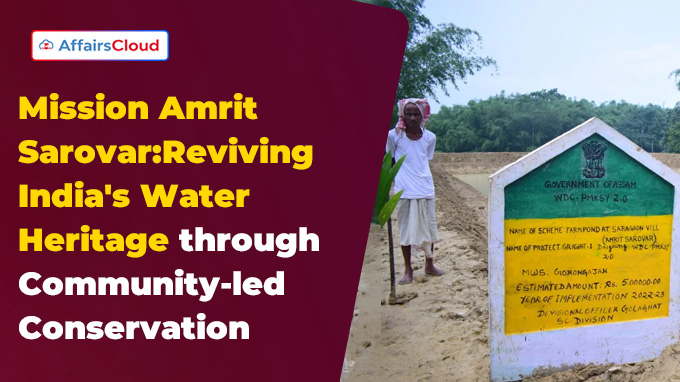 The Mission Amrit Sarovar, a flagship initiative under the Azadi Ka Amrit Mahotsav, was announced on 24th April 2022 by the Prime Minister(PM) Narendra Modi during the celebration of National Panchayati Raj Day at Palli Gram Panchayat, Samba District, Jammu, Jammu & Kashmir(J&K)
The Mission Amrit Sarovar, a flagship initiative under the Azadi Ka Amrit Mahotsav, was announced on 24th April 2022 by the Prime Minister(PM) Narendra Modi during the celebration of National Panchayati Raj Day at Palli Gram Panchayat, Samba District, Jammu, Jammu & Kashmir(J&K)
- The objective of this mission is to construct/rejuvenate at least 75 Amrit Sarovar (ponds) in every district of the country.
- Each Amrit Sarovar is designed to have a pondage area of minimum of 1 acre (0.4 hectare) with water holding capacity of about 10,000 cubic meter (m3).
About Mission Amrit Sarovar:
The Mission Amrit Sarovar follows a “Whole of Government” approach, involving multiple ministries and organizations for effective implementation.
i.The initiative involves the following seven ministries:
- Ministry of Rural Development(MoRD), Ministry of Jal Shakti(MoJS), Ministry of Panchayati Raj(MoPR), Ministry of Environment, Forest & Climate Change(MoEFCC), Ministry of Railways(MoR), Ministry of Culture(MoC) and Ministry of Road Transport and Highways(MoRTH).
ii.This mission is also supported by the Bhaskaracharya National Institute for Space Applications and Geo-informatics (BISAG-N).
iii.The National Informatics Centre (NIC) has provided a centralized digital platform amritsarovar.gov.in which tracks real-time progress at the granular level.
iv.As of March 2025, over 68,000 Sarovars have been completed, out of which 46,000 sarovars were constructed/rejuvenated under MGNREGS.
Implementation:
Mission Amrit Sarovar is being implemented by states and districts through the integration of various ongoing schemes, such as the Mahatma Gandhi National Rural Employment Guarantee Scheme (MGNREGS), 15th Finance Commission(FC) Grants, and sub-schemes of the Pradhan Mantri Krishi Sinchayee Yojana (PMKSY), including the Watershed Development Component and Har Khet Ko Pani, along with the states’ own initiatives.
Monitoring the Progress:
i.Each Amrit Sarovar will have one Panchayat Pratinidhi and one Panchayat level officer.
ii.Gram Panchayat will nominate Panchayat Pratinidhi, who will act as citizen supervisor, and will be responsible for fair execution of the Amrit Sarovar.
iii.Panchayat level officer will monitor the progress and ensure faithful implementation of the mission and also submit appropriate documents, photos and videos.
Phase I (April 2022 – August 2023):
i.The target to build 50,000 Amrit Sarovar by August 15, 2023, was achieved in May 2023 itself.
ii.Each completed Amrit Sarovar has a common signage board stating all the details of the site and mandatory plantation of trees such as Neem, Bargadh, Peepal and any other native trees.
Phase II (Ongoing Since September 2023):
i.Phase II of Mission Amrit Sarovar focuses on water availability through community participation (Jan Bhagidaari), strengthening climate resilience and ecological balance for future generations.
ii.So far 65,285 user groups have been formed for each Amrit Sarovar. These user groups are fully involved during the entire process of development, execution and utilization.
Top 5 performing states as of March, 2025:
| Rank | State | Number of Amrit Sarovars Completed |
|---|---|---|
| 1 | Uttar Pradesh, UP | 16,630 |
| 2 | Madhya Pradesh, AP | 5,839 |
| 3 | Karnataka | 4,056 |
| 4 | Rajasthan | 3,138 |
| 5 | Maharashtra | 3,055 |
Ecological Impact:
i.The Ground Water Resources Assessment by Central Ground Water Board (CGWB), in collaboration with State Governments, shows a significant rise in groundwater recharge.
ii.Recharge from tanks, ponds and water conservation structures increased from 13.98 Billion Cubic Meters (BCM) in 2017 to 25.34 BCM in 2024, reflecting the success of water conservation such as Mission Amrit Sarovar.




